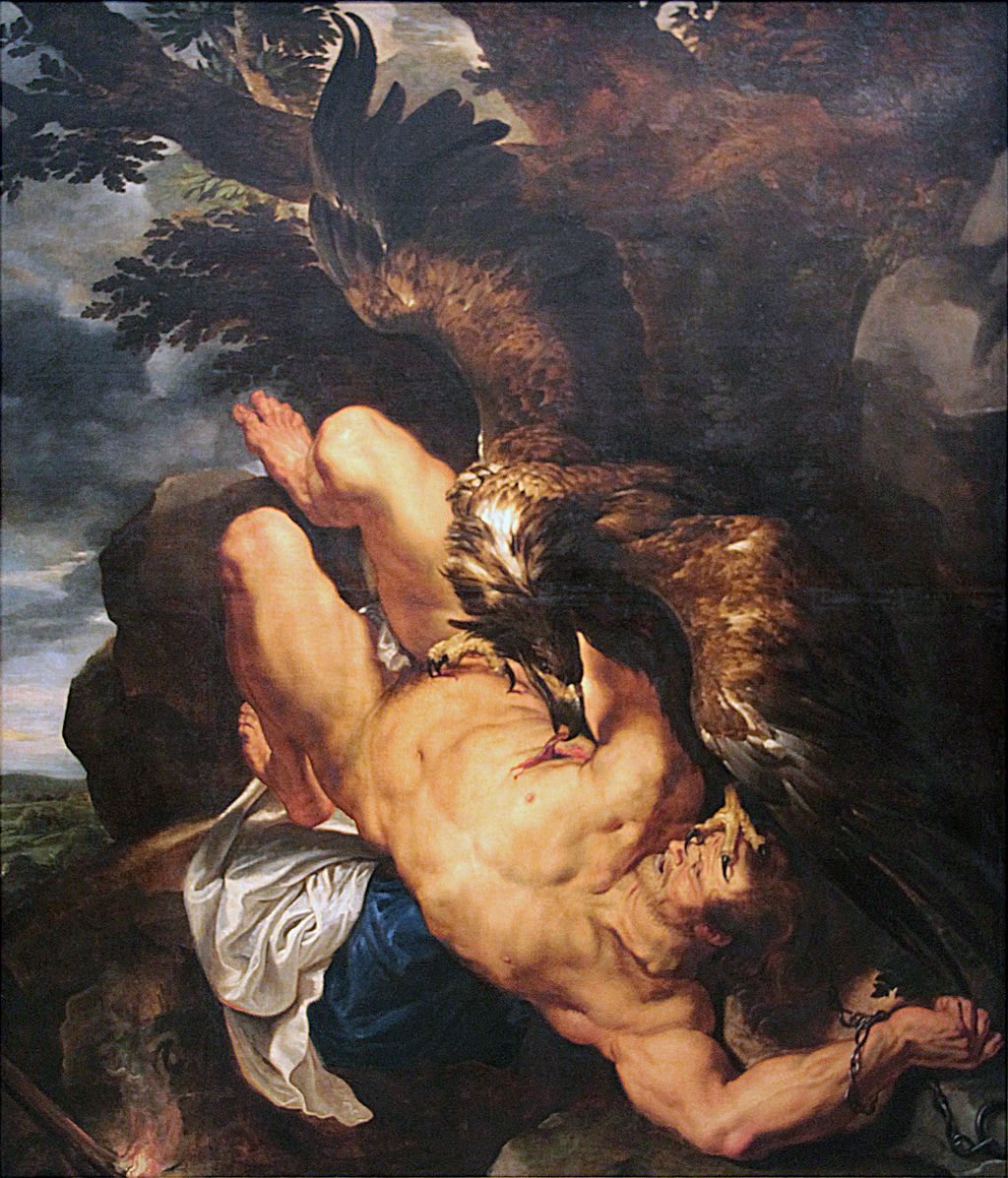“Prometheus Bound” by Peter Paul Rubens and Frans Snyders depicts the punishment of Prometheus. The immortal Prometheus was bound to a rock.
Peter Paul Rubens completed this painting in his studio with collaboration from Frans Snyders, who rendered the eagle.
Each day an eagle, the emblem of Zeus, was sent to feed on his liver, which would then grow back overnight to be eaten the next day again.
In ancient Greece, the liver was thought to be the seat of human emotions.
In Greek mythology, Prometheus was a Titan who defies the gods by stealing fire and giving it to humanity, an act that enabled progress and civilization.
As a consequence, Zeus, king of the Olympian gods, sentenced the Titan to eternal torment for his transgression. Prometheus was eventually freed by the hero Heracles (Hercules).
Prometheus was known as a champion of humankind. He was also regarded as the patron of the human arts and sciences generally.
In the Western classical tradition, Prometheus became a figure who represented human striving, particularly the quest for scientific knowledge, and the risk of overreaching or unintended consequences.
In particular, he was regarded in the Romantic era as embodying the lone genius whose efforts to improve human existence could also result in tragedy.
Mary Shelley gave the subtitle: “The Modern Prometheus” to her novel Frankenstein (1818).
Prometheus Bound
“Prometheus Bound” refers to an Ancient Greek tragic play. The tragedy is based on the myth of Prometheus, who defies the gods and gives fire to humankind, an act for which he is subjected to eternal punishment.
Prometheus Bound was the first work in a trilogy that also included the plays “Prometheus Unbound” and “Prometheus the Fire-Bearer,” neither of which has survived.
Since the final two dramas of the trilogy have been lost, it is difficult to determine the author’s original intention for the work as a whole. It was initially attributed to Aeschylus (525/524 – c. 456/455 BC), but that is now in dispute.
In the early 19th century, the Romantic writers came to identify with the defiant Prometheus. Johann Wolfgang von Goethe wrote a poem on the theme, as did Lord Byron.
Percy Bysshe Shelley wrote a play, Prometheus Unbound, which used some of the ideas of the play as a vehicle for Shelley’s vision. More recently, Ridley Scott’s returned to the Alien universe with his movie Prometheus.
Prometheus Unbound by Shelley is a fiercely revolutionary championing free will, goodness, hope, and idealism in the face of oppression.
“To suffer woes which Hope thinks infinite;
To forgive wrongs darker than death or night;
To defy Power, which seems omnipotent;
To love, and bear; to hope till Hope creates
From its own wreck the thing it contemplates.“
Peter Paul Rubens
Peter Paul Rubens was a Flemish artist who is considered the most influential artist of the Flemish Baroque tradition.
Rubens specialized in making altarpieces, portraits, landscapes, and history paintings of mythological and allegorical subjects.
His compositions referenced classical and Christian history and emphasized movement, color, and sensuality.
Frans Snyders
Frans Snyders (1579 – 165) was a Flemish painter of animals, hunting scenes, market scenes, and still lifes.
He was one of the earliest specialists “Animal painters,” and he is credited with initiating a wide variety of new still-life and animal subjects in Antwerp.
He was a regular collaborator with leading Antwerp painters such as Peter Paul Rubens, Anthony van Dyck, and Jacob Jordaens.
Prometheus Bound
- Title: Prometheus Bound
- Artists: Peter Paul Rubens and Frans Snyders
- Year: 1618
- Medium: Oil on canvas
- Dimensions Height: 242.6 cm (95.5 ″); Width: 209.5 cm (82.4 ″)
- Museum: Philadelphia Museum of Art
Peter Paul Rubens
- Artist: Peter Paul Rubens
- Born: 1577 – Siegen, Nassau-Dillenburg, Holy Roman Empire
- Died: 1640 (aged 62) – Antwerp, Spanish Netherlands
- Nationality: Flemish
- Movement: Flemish Baroque, Baroque
- Major Works:
- The Judgment of Paris
- Adam and Eve
- Samson and Delilah
- Massacre of the Innocents
- The Last Supper
- Miraculous Catch of Fish
- Honeysuckle Bower
- Battle of the Amazons
- The Battle of Anghiari – Copy of Leonardo da Vinci’s Lost Painting
- Diana and Callisto
- Prometheus Bound
Peter Paul Rubens, “Prometheus Bound”
Frans Snyders
- Artist: Frans Snyders or Frans Snijders
- Born: 1579, Antwerp
- Died: 1657, Antwerp
- Nationality: Flemish
- Famous Works:
- Prometheus Bound
The myth of Prometheus
PROMETHEUS BOUND
A Tour of the Philadelphia Museum of Art
- “The Burning of the Houses of Lords and Commons by J. M. W. Turner
- “The Large Bathers” by Auguste Renoir
- “Crucifixion Diptych” by Rogier van der Weyden
- “At the Moulin Rouge, The Dance” by Henri de Toulouse-Lautrec
- “The Large Bathers” by Paul Cézanne
- “The Death of Sardanapalus” by Eugène Delacroix
- “ Noah’s Ark” by Edward Hicks
- “Prometheus Bound” by Frans Snyders
- “Woman with a Pearl Necklace in a Loge” by Mary Cassatt
- “Portrait of Frances Sherborne Ridley Watts” by John Singer Sargent
PROMETHEUS – Greek Play
Aeschylus’ Prometheus Bound
Prometheus – Evolution of the myth
~~~
“Time, as it grows old, teaches all things.”
– Aeschylus, Prometheus Bound
~~~
Photo Credit: 1)Frans Snyders [Public domain] by Jean-Pol GRANDMONT; Peter Paul Rubens / Public domain
Popular this Week








 Sponsor your Favorite Page
Sponsor your Favorite Page SEARCH Search for: Search Follow UsJoin – The JOM Membership Program
Sponsor a Masterpiece with YOUR NAME CHOICE for $5
Share this:
- Tweet

